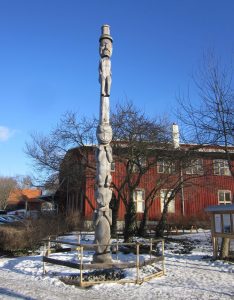The controversy that I will be discussing today has been resolved but is nevertheless a good example of the controversial acquisition of indigenous property without regard for its cultural significance. In 1929 the G’psgolox Totem Pole was taken from the Haisla people of British Columbia and shipped to the Swedish National Museum of Ethnography in Stockholm. The Haisla are an amalgamation of two bands, the Kitamaat people and the Kitlope People. The G’psgolox pole was a Mortuary pole, which was planted over the graves of chief G’psgolox’s family, to commemorate the deaths of his family and other members of the tribe who died during a smallpox epidemic. The Haisla traditions for mortuary poles dictate that they are not to be interfered with or preserved, but allowed to naturally decay and fall apart, a process which in the temperate climate takes between 60-100 years.
The exact details of the poles removal are uncertain, but we do know that the pole was taken by a man named Iver Fougner with permission from the Canadian Department of Indian Affairs, but there is no clear record as to whether he received permission from the Haisla people themselves, with the only written documentation being of the official papers allowing the pole to be exported to Sweden. The Haisla claim the pole was taken without their knowledge, while the museum say that it was sold to them by the tribe who needed money. Following the poles removal subsequent generations of the Haisla people would search for evidence of the pole eventually rediscovering it in 1991. Two members of the Haisla people, Louisa Smith and Gerald Amos, would travel to Sweden to request repatriation by the pole, which under Swedish law was now the property of the Swedish government.
After three years the Swedish government agreed to repatriate the pole, but under two conditions. Firstly that a replica pole was created and shipped to Sweden to replace the G’psgolox pole, and secondly that the original was preserved and housed in a suitable facility in British Columbia. In 2000 the replica was shipped to Sweden, and a replica was also raised in the location of the original. The replica in Sweden was completed on the museum property, and the carvers interacted with the museum visitors sharing the history of the pole from their perspective. It would take 6 more years before the Haisla were able to raise the funds and establish a suitable facility to house the G’psgolox pole, with it being placed in the local shopping center in 2006 due to a lack of a suitable museum. In 2012 based on the decision of elders of the Haisla the totem pole was taken to an old graveyard near the original location of the pole and left to decay.
Despite being a somewhat successful example of a repatriation of an important artifact to a indigenous group the repatriation of the G’psgolox pole remains controversial, as the Swedish government never admitted fault for taking the pole, the Haisla were only able to receive it in exchange for producing a replica, which they paid to create and ship to Sweden, and the pole was not originally permitted to be disposed of in the traditional way.
My question for this week’s discussion is this: in your opinion, to what extent can replicas of artifacts replace original examples, either for a museum or indigenous populations use?

I think that replicas fall under a category that can be good, but could also be bad. If something is too fragile to move, a replica in it’s place does seem like the safer option. However, if there isn’t something that states that it is a replica, that’s when it starts to get into questionable territory. Like in your article, only giving back a stolen piece by an exchange of a replica is not the best way to represent a replica. It’s a hard question, I feel like it’s all purely circumstantial.
I think that replicas are just fine for a museum. Honestly, I like knowing that what I’m viewing at a museum is the real deal, but if it comes down to an artifact being stolen, well, put a replica in the museum. And for heaven’s sake, have the museum pay for the replica! They’re the ones who want that particular piece, after all.